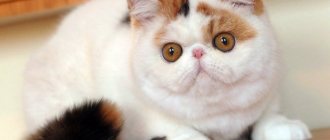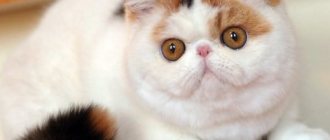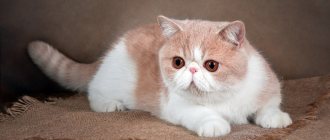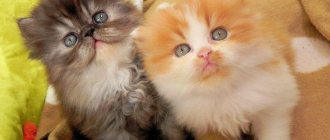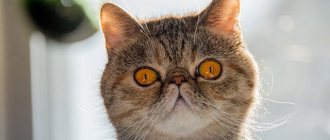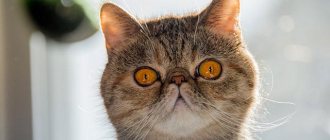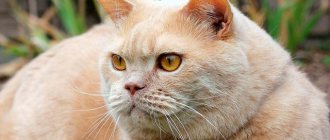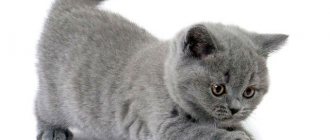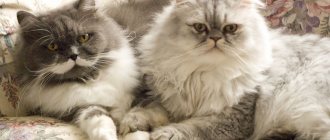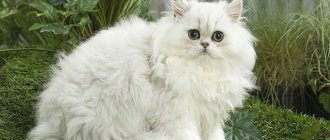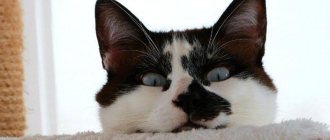Persian cats are one of the most popular breeds nowadays. They are amazingly sweet and kind creatures, capable of becoming a full-fledged member of the family, brightening up lonely everyday life and simply lifting your spirits. And this is not due to their attractive appearance of the animal, but due to the sweet and kind disposition of the animal. See also the cutest cat breeds.
History of the breed
There are two versions of where and when the Persians appeared. According to one, Persian cats first appeared in Italy probably in the 17th century. One Italian merchant was making a long sea voyage and while in Persia he saw a uniquely beautiful cat that made him fall in love with her. The navigator brought the beauty to Italy for breeding, but what happened to her next is unknown.
After some time, Persians appeared in Paris, and after a while this breed spread throughout France. The Persians were liked by many aristocrats.
Soon, Cardinal Reshelier himself learned about the amazing cats, and he was quick to buy a Persian kitten for himself. He was one of the first to breed Persians in France. Also, this breed came to the court of the French king.
Then the Persians began to appear throughout Europe. In England, for the first time, they began to research the breed and breed Persian cats, developing new species and colors.
Description of the breed
The Persian physique is large, powerful, quite muscular, and has a wide chest. The paws are strong and low. The head is large, proportional to the body. At the same time, the Persian neck is short, but strong enough to hold a rather large head.
The Persian's muzzle is slightly flattened, has a large convex forehead, a massive jaw, a small upturned nose with open sinuses (see all photos of the Persian cat).
The eyes of these cats are round, the eyelids are small, it seems that they are always open. Their ears are very small, slightly rounded, widely spaced, protected by small tufts of hair.
The tail of Persian cats is not long, very fluffy, slightly rounded at the end. Persian cats come in many colors, both solid and multi-colored.
PERSIAN CAT (PERS) (haircut, combing)
1
Grooming, washing, combing, removing mats from CATS without anesthesia.
Grooming, washing, combing, removing mats from CATS without anesthesia.
Grooming, washing, combing, removing mats from CATS without anesthesia.
Grooming, washing, combing, removing mats from CATS without anesthesia.
Grooming, washing, combing, removing mats from CATS without anesthesia.
Grooming, washing, combing, removing mats from CATS without anesthesia.
Grooming, washing, combing, removing mats from CATS without anesthesia.
Grooming, washing, combing, removing mats from CATS without anesthesia.
Grooming, washing, combing, removing mats from CATS without anesthesia.
Grooming, washing, combing, removing mats from CATS without anesthesia.
1
Persian cats cannot live outside the house. In general, cats of this breed are distinguished by their affectionate nature and complete trust in humans. Families often choose an owner who is loved and respected. Very calm. Their voice is rarely heard. The Persians calmly and persistently ask you to pay attention to them: they sit near the owner and look intently into his face. They accompany everyone at home from room to room and are not afraid of children. Even though Persians are considered couch potatoes, they can be quite active when played with. Even adult cats rush after the ball with enthusiasm. They also like to catch insects that accidentally fly into the house. Persians are curious by nature, and love to explore new and unfamiliar corners of the room. Now there are about 100 varieties of these cats by color. There are black, white, gray, blue, red, cream, red, and lilac cats. Eye color: dark orange, blue, copper, green. Cats of a certain color have their own eye color. Cats of the same color should not have spots or shades. Cats with markings on the head, paws and tail are called color point. Around 1970, many Persian catteries appeared in America, which led to changes in the breed not for the better, since many cats with selection defects were sold to Europe. About 20 years ago, specialists in Europe managed to breed a typical, healthy cat that meets breed standards. In 1933, the “exotic” breed was bred in one of the largest nurseries in Europe. In type and character it corresponds to the Persian cat, but they have short, thick, “plush” hair. This is an ideal option for those who love the “baby faces” of Persian cats, but do not have time to care for them on a daily basis. In the Soviet Union, the first Persian cats appeared only in the late 80s of the last century. They were brought from Europe by diplomats and were very rare. In the early 90s, the breed began to spread throughout the country, while remaining an expensive pleasure. A distinctive feature of the breed is a small, wide and snub nose. The type of cat with a very small, upturned nose is called “extreme”, while a relatively long and slightly upturned nose is called “classic”. The short and muscular legs also stand out. The extreme type is bred mainly in the USA, and the classic type - in Europe. The weight of an adult cat can reach 7 kilograms. A skull that is too flat or too high, watery eyes, difficulty breathing, and a body that is too light or stretched are serious faults, as is a matted, over-powdered or uneven coat. The most common condition defects are mats or bald spots after combing out the mats. The coat is long, with a thick, very soft undercoat . The eyes are round, large, dark blue, dark orange, and may also have differently colored eyes (one eye is dark blue, the other is dark orange). The coat color is pure white, without any admixture of other colors or shades. The nose and paw pads are pink. Young animals may have black, blue, red or cream spots on the head, which disappear with age. Persian white blue-eyed varieties may be deaf from birth. This drawback causes too much trouble for the owners. Being the owner of a deaf cat means protecting it from road accidents and other unforeseen situations, so it is better to keep such a cat at home. Deaf blue-eyed cats have a hard time making contact with other cats and, since they do not hear warning or threatening sounds, they are forced to navigate by facial expressions and gestures. If the mother suffers from deafness, then she should be placed on a hard surface so that she can feel the vibration from the sounds of her kittens. It should be noted that deaf kittens can be born from two parents with normal hearing, but it happens that kittens that are deaf from birth acquire hearing as they grow up (especially if they have a dark spot on their head at birth). Deaf cats and female cats should not be crossed together as this may result in weak offspring. The coat color is black , like a raven's wing, from the tips to the roots of the hair, without gray undercoat and individual white hairs. Brown or rusty coat color is a fault. The nose and paw pads are black or grayish-black. Eye color is smooth copper or dark orange. The coat of young animals under six months of age often has a rather poor coloration. The above-mentioned coat color defects may occur. However, this should not serve as a reason for culling young animals: coloration, as a rule, improves with age. Sunlight has a detrimental effect on the color of the coat, so it is advisable to keep it away from windows and not to go outside with it. This is one of the most difficult breeds to care for. A cat's fur needs to be carefully looked after every day, otherwise it becomes tangled, the undercoat falls off, and numerous tangles form. You should powder the coat daily with talcum powder or a special chalk-based powder, then comb it thoroughly with a comb or brush. In addition, regular washing is required. In addition to fur, these cats have two significant disadvantages that arose as a result of selection. This is a defect of the nasal septum due to a flattened nose, which is why cats constantly sniffle and even snore, and constant discharge from the eyes due to blockage of the lacrimal glands. In order for your cat to always be well-groomed, you will need the following items: a comb with sparse and thick teeth, a brush with metal and natural bristles, a toothbrush, a grooming glove, a suede cloth, scissors with blunt ends, a rubber brush. For cats with short hair, a grooming glove, a suede cloth, and a comb are suitable.
Now let's try to figure out how to cut our Persian cats . Having more than 10 years of experience working with cats, I believe that if your Persian cat is not a show cat, that is, does not currently participate in such events, then the haircut options can be absolutely anything. Dear owners of Persian cats, a cat is an addition, a piece of you and your style and taste, it is simply necessary to trim your Persian. It is impossible to spoil a Persian cat with any exotic haircut. Its fur is very similar to hair; the more often and shorter you cut it, the better and better the quality of the wool becomes.
Body Grooming for Persian Cats:
- “Cut to the breed”, when everything is cut in accordance with the standards as for an exhibition (haircut with a light edge). The length of the coat varies depending on the wishes of the owner and the exterior of Persian cats.
- “Lion haircut”, when the hair on the body is cut completely to 0.5 cm, and only remains on the paws, tail and mane like a lion. All remaining fur is trimmed with a smooth transition to the trimmed body.
- “Dinosaur haircut” when the hair on the body is cut completely to 0.5 cm, leaving only a strip of hair on the spine, back, legs, tail and mane. All remaining fur is trimmed with a smooth transition to the trimmed body. The strip of fur on the back is cut into ridges like a dinosaur's.
Haircut of the head and face of Persian cats:
- “Grooming according to the breed”, when everything is cut in accordance with the standards as for an exhibition. The length of the coat varies depending on the wishes of the owner and the exterior of Persian cats.
- “Leo cut”, when hair is left on the face, neck and sometimes shoulders of Persian cats. The remaining fur is trimmed and smoothly brought down to a short body.
- “Dinosaur cut”, when hair is left on the face, neck and sometimes shoulders of Persian cats. The remaining fur is trimmed and smoothly brought down to a short body.
Tail trim for Persian cats:
- “Grooming according to the breed”, when everything is cut in accordance with the standards as for an exhibition. The length of the coat varies depending on the wishes of the owner and the exterior of Persian cats.
- “Leo haircut”, when the entire tail is cut to 0.5 cm, and a tassel is left at the tip or left entirely.
- “Dinosaur haircut” - the tail can be cut like a Lion’s or cut into a braid, herringbone or spikelet pattern.
Paw trimming for Persian cats:
- When “Cutting according to breed”, only the paw pads and the fur on them are cut to “0” on the paw. The length of the fur on the paws most often varies depending on the wishes of the owner and the exterior of the Persian cat.
- When “cutting like a Leo”, “socks” are left on the paws, and the hair on the pads is cut to “0”.
- When “cutting like a Dinosaur”, “socks” are left on the paws, and the hair on the pads is cut to “0”.
Dear owners of Persian cats, let's move away from the stereotypes imposed on us that Persian cats are cut like this, but not cut like that... You and only you choose to be you and your cat as an “exclusive individual” or a “gray mass” like everyone else!
You just need to decide which master’s work you liked. We will do the rest. You don't even need to call yourself.
- You simply sign up on the website to see the master, and send the application to us.
- Or you can order a call back on the website, and we will call you back at a time convenient for you.
Well, when could we even dream that caring for our beloved CATS and further maintaining all this CAT beauty would be so simple. We decided to move away from the stereotypes of the past imposed on us. Now you don’t need to sign up for a beauty salon and go to a specialist whose work you sometimes don’t know and aren’t sure whether you’ll like the result. And then you will have to pay quite a small amount for the procedures at the cash register at the administrator. The result in most cases is the same:
- Either you liked the master and you would like to continue to be serviced by him, but we all know that the prices are high in a good salon, where there are good, professional and experienced masters.
- Either you didn’t like the master and you have to look for a new one...
We offer you, without leaving your home:
- Choose a suitable master for yourself by looking at his work.
- Agree on the place and time of the procedure (at your home or in the specialist’s office).
- And get an excellent price, from what they can give you in any beauty salon, for high-quality, professional procedures.
We do not skimp on the quality of services ; we have been able to seriously reduce prices for procedures and services due to the fact that we do not rent expensive premises; all our specialists receive clients in their equipped offices. Or they come to your home. Pet salon in Zhulebino in Moscow Salon-Zoo.Ru offers the following services: trimming a Persian cat, exhibition and home grooming a Persian cat, including grooming a Persian cat in Zhulebino, washing a Persian cat, cleaning the ears of a Persian cat, cutting and trimming claws of a Persian , cleaning the teeth of a Persian cat, cleaning the glands of a Persian cat. An inexpensive haircut for a Persian cat in Moscow at home or in a salon is a vital necessity for animal owners; it allows you to keep the dog’s coat clean, especially if it participates in exhibitions and needs a model haircut. Our best professional groomers do their work inexpensively (reasonable price) and with high quality. We work in Reutov, Novokosino, Kosino, Nekrasovka, Saltykovka, Balashikha, Novogireevo, Zhulebino, Lyubertsy, Shchelkovo, Kotelniki, Lytkarino, Perovo, Vykhino, Zheleznodorozhny, Ivanovskoye, Golyanovo, Izmailovo, Tekstilshchiki, Kuzminki, Maryino, Brateevo, Kapotnya.
We really value each of our clients!
Personality of the Persian cat
Breeders of Persian cats say that this breed not only has an amazingly beautiful appearance, but also an affectionate, gentle disposition. Persians are real pets. They love to sit in their owner's arms and love to be petted.
Persians are very active and enjoy playing with toys. They are attached to all family members, especially children, the only thing they do not allow kids to do is grab themselves. Curiosity is in their blood, so Persian cats explore everything new, be it the shoes of one of the guests or just a bag of clothes or food standing in the hallway.
Persians hate being alone and have a hard time with separation. They can purr plaintively all day long while their owners are not at home, but when he comes, they will ask to be held or get underfoot.
Character
Persians and exotics are ideal pets for people who do not like fuss and have a sedate and measured way of life. These are good-natured "lumps"
,
affectionate
and
gentle
.
They are not in a hurry and will not rush around the apartment; they prefer to sleep or lie down imposingly. Like real aristocrats, they are very lazy, phlegmatic and calm
. Modest and quiet, they rarely speak out. Unobtrusive, but loyal to the owner. They are patient with being cuddled and carried in their arms; they rarely express this desire on their own. Quite smart, well mannered and have self-esteem. They rarely show aggression and are peaceful. At the age of a kitten, Persians and exotics are quite playful, but adults prefer a calm horizontal position.
Contents of the Persian
These pets are not the easiest to care for. The priority areas are fur and eyes.
The fur of Persian cats can mat and form tangles and tangles. To carefully care for her, you need to have shampoos and conditioners special for this breed, sprays that make combing easier, talcum powder, as well as several combs with large and fine teeth.
Persian fur needs to be groomed every day, or every other day at most. Thus, it will not take a lot of time, nerves and effort from either the owner or the pet. If you are not going to participate in championships or exhibitions with your cat, then especially in the hot season, you can cut it, this will make care much easier.
Let's especially focus on the eyes. “Tears” that form in the corners of the eyes can make it difficult for the animal to breathe; as they occur, they must be removed with a cotton swab.
If you notice that your cat is snoring, don't be alarmed, this is normal. Since Persian cats have a deviated nasal septum, they can make sounds similar to snoring while sleeping.
Care and maintenance
The main thing in caring for the Persian breed is caring for their main advantage – their coat
.
A long fur coat requires regular attention. Combing and bathing the animal is mandatory, especially during the molting period, otherwise the fur will roll up and become tangled. Persians do not like to wash themselves. It is necessary to teach this procedure from the age of the kitten and find a common compromise. Particular attention should be paid to drying the coat after bathing. This is necessary, since due to the structure of the short nasal passages the animal may catch a cold. Caring for an exotic shorthaired breed is less demanding; it also requires periodic brushing, bathing and drying, but not as often as with Persians. Therefore, exotics are sometimes called “Persians for the lazy
. A short muzzle and long hair provoke more frequent contamination of the eyes and nose, so regular hygiene of the eyes, nose, and ears is required. Persians and exotics love a calm and warm place to sleep and relax, without drafts, where no one will disturb them. Since this breed has low motor activity, there is no need for a large play complex or a cat tree, just a full-fledged scratching post, suitable for the size, where the animal can easily clean its claws. Nutrition must be complete and balanced to maintain the beauty of the coat, proper growth and development of the cat. Vaccination, treatment against helminths and preventive visits to a veterinarian are mandatory.
Feeding
Before getting a Persian cat, decide how you will feed it, since combining feeding with natural food and food will not work. The question arises, why? After all, ordinary, not purebred cats can eat both.
The situation is that when natural food is digested, special substances are formed in the animal’s stomach, which have a special effect on the animal’s liver, and when dry food is digested, other enzymes are involved in digestion.
The impact is increasing. Therefore, constantly changing food increases the load on the digestive system and your Persian cat's liver can quickly wear out. And yet, do not forget that they are more fragile creatures than barn cats.
The easiest way to feed your Persian cat is dry food, as they are perfectly balanced and enriched with a large amount of vitamins and amino acids that the animal needs throughout its life.
It is recommended to alternate feed. It is imperative to ensure that the cat has a constant opportunity to drink. Change the water in the bowl daily, or better yet, a couple of times a day. It is advisable not to pour tap water, use purified water.
If you are feeding your Persian beauty with natural products, then remember that a balanced diet has not been canceled. Her food should contain proteins obtained from meat, offal or fish, about half a bowl, and the other half, cereals, cereals, stewed vegetables.
You can add a couple of drops of refined oil to your food, which has a very good effect on digestion and improves the condition of the coat. You cannot feed Persians food with spices, sausage, bones, pasta and potatoes. If you want to give your pet fish, then this should be done only a couple of times a month, and the fish should be steamed and boneless.
Colors
In nature, there are many colors of Persian cats. They come in both single color and multicolor.
Let's look at the most common ones:
- White peaches are amazing in their beauty; such peaches require special care.
- Grays are the most common, they come in both gray-pebble color and smoky, gray-blue.
- Black - despite the fact that they are not often found, they are not in particular demand.
- Redheads are very pretty, affectionate sissies.
- Blue ones are unusually beautiful, somehow majestic. Queen Victoria of England herself had a blue Persian cat.
- Cream - born from Persian cats with a weakened gene responsible for the color of the future generation. At the same time, these kittens are very cute.
- Purple peaches are very rare animals, they can rarely be found even in nurseries; to see them with your own eyes, you need to go to an exhibition.
- Red - or orange-red, one of the most ancient types of Persian cats.
- Two-color - there are a lot of options and combinations.
- Tabbies are tortoiseshell or brindle, with a specific pattern all over their body.
- Chinchillas are extraordinary animals, but they are not very easy to buy, nor are they cheap.
Diseases
Typically, Persian cats rarely get sick. With proper care and if everything is in order with heredity, then these are surprisingly active and playful animals. Persians, however, have several genetic diseases.
These include polycystic kidney disease, retinal atrophy, leading to the animal’s blindness; it can be diagnosed in a kitten as early as the second month. There may also be a problem with teeth; Persian cats should definitely be shown not only to a veterinarian, but also to a dentist.
Also, in some cases, problems with the heart and blood vessels are possible. Because of this, Persians do not tolerate travel and travel well.
You can buy a Persian kitten in almost any city where there are nurseries. Since these cats are very common, there are many breeders of them.
Different prices. They depend on the color and pedigree of the animal. On average, the price ranges from two to twenty-five thousand rubles.
Appearance
Persian and Exotic Shorthair breeds have a dense cobby-type
, square format with developed muscles. These are large animals, squat with a massive body. The weight of adult representatives is 4-7 kg. The chest is wide and deep. The body is equally massive and wide at the shoulder and hip girdles, with a well-rounded middle part and a straight back. The limbs are thick, short, powerful. The paws are large, round, dense with tufts of hair between the toes. The tail is short, straight, proportional to the body, with a blunt or slightly rounded tip, slightly below the line of the back and well furred.
A distinctive feature of Persians and exotics is their head and muzzle. The outdated classic version does not have a “flattened” muzzle, their nose is long, the nose is directed downwards and vertically. These representatives are not used for breeding and are sold only as pet-class animals.
The head of the modern Persian and exotic cat is round, massive, with a wide convex skull, wide at the cheekbones, and harmonious. The facial part is round with a rounded bone structure, the forehead is round. Cheekbones are low and wide. Cheeks – round, full. The nose is short, upturned, wide with a sharp transition - “stop”
from forehead to nose.
The length of the nose does not exceed its width. The nose is wide, slightly convex. The nose mirror is well designed. The chin is strong, wide, ideally in a vertical line with the nose. The jaws are strong, with the correct bite, let's say an overshot of 2-3 mm. The line of the upper lip creates the impression of a “smile”
.
The eyes are large, round, expressive, wide open, set wide and straight, slightly surprised - which creates a cute “baby-face”
. The color is uniform and matches the coat color. The ears are small, low set, with rounded tips, well pubescent with good internal tufts. The Persians' whiskers can have an interesting direction - forward and curved upward.
15 cm long
, thick, dense wool with a delicate, airy texture. It is soft, shiny, “alive”, and in good condition. Same length throughout the body. A thick collar covers the neck and shoulders and extends down to the front legs. "Watiness" is not acceptable.
Exotic wool
considered short, it is slightly longer than other short-haired cats. Thick, plush, soft texture, non-fitting, tightly stuffed.
Colors of Persian and Exotic Shorthair breeds
Among Persians and exotics, white, tabby and color-point colors are more common, and solid, silver and golden chinchillas are less common. When assessing color, attention is paid to the color of the coat, pattern, color of the eyes, paw pads and nose.
Solid, solid colors
Black(n)
– black color from tip to roots, without “rust”, without white hairs, without pattern and gray undercoat. The nose and paw pads are black. Eye color – orange or copper, uniform, without inclusions. Kittens may have the so-called “moiré” - a residual pattern; their fur is dark gray with white hairs; complete coloring occurs with age.
Blue (a)
– all shades of blue from light gray to rich steel blue. The color should be clean and uniform, without white hairs or tints. The nose and paw pads are bluish-gray. Eye color – orange or copper.
Chocolate (b)
– all shades of brown, without “rust”, white hairs or patterns. The color is uniform, without gray undercoat. The nose is the color of milk chocolate. Paw pads are the color of cinnamon or chocolate. Eye color – orange or copper.
Lilac (c)
– pale lilac coat with a pinkish tint, without white hairs or patterns. The color is uniform, without gray undercoat. The nose is purple. Paw pads are lilac-pink. Eye color – orange or copper.
Red (d)
– warm red-red color from roots to tips, without marks or light spots. Light shades on the forehead and limbs are acceptable. The nose and paw pads are brick red. Eye color – orange or copper.
Cream (e)
– pastel beige uniform color without an orange tint, without patterns or marks. The undercoat should not be light (white). Eye color – orange or copper.
White (w)
– pure white color without marks or patterns. The nose and paw pads are pink. Kittens may have small blue, red, black, or cream spots on their heads that disappear with age. Eye color – orange or copper, blue, possibly “odd-eyed” – one eye is orange, the other is blue.
Tortoiseshell colors and Particolors
Black tortoiseshell (f)
– a combination of the two primary colors black and red in different proportions. A uniform distribution of colors and the presence of red on the face is desirable. Various shades of red are allowed. The nose and paw pads are black, pink or black with pink spots. Eye color – orange or copper.
Blue-cream tortoiseshell (g)
– a combination of blue and cream colors throughout the body, on the limbs, muzzle, and tail. Lighter shades are preferred. The nose and paw pads are bluish-gray, cream or gray with cream spots. Eye color – orange or copper.
Chocolate tortoiseshell (h)
– a combination of rich, warm chocolate and areas of red. Red can be lightened shades. The nose is the color of milk chocolate, pink or chocolate with pink spots. Paw pads are cinnamon or chocolate colored, pink or chocolate with pink spots. Eye color – orange or copper.
Lilac-cream tortoiseshell (j)
– rich, warm lavender with cream flecks. The nose and paw pads are lilac, pink or lilac with light pink spots. Eye color – orange or copper.
Calico (tortie-and-white)
– a combination of black, red and white colors in various combinations. The nose and paw pads are the same color as the base color. Eye color – orange or copper.
The tortoiseshell color group can be solid or tabby. For a correct determination, it is necessary to evaluate the absence or presence of a pattern on the black (blue, chocolate, lilac) part of the color, since red genetically always has a pattern.
Tabby colors
Tabby is not a color, but characterizes a pattern on the main background, which is manifested due to the presence of the “A” (agouti) gene in the animal.
Marble
(encoding 22) – a clear pattern in the form of wide lines. Large stripes run along the back from the withers to the tail. Several necklaces are attached to the neck. A “butterfly” pattern can be formed on the shoulder blades and curls can be located on the sides. There are 2-3 wide rings on the tail.
brindle
(code 23) – the stripes are narrower, starting from the center line on the back and descending in narrow stripes on the sides. The necklaces on the neck are thinner, the tail is striped.
Spotted
(code 24) – against a lighter background of the main color, clear contrasting spots are evenly located throughout the body. They can be round, oblong, or in the form of rosettes. There are spots on the limbs and preferably on the tail (open rings are acceptable).
The common features of all tabby patterns are the outline of the nose, eyes, the letter “M” on the forehead and the “scarab” on the top of the head. Tabby colors with the presence of the “silver” gene (inhibitor) have a light (almost white) undercoat.
Bicolor colors
Persian and exotic shorthair breeds have three options for combining white and any base color: van, harlequin, bicolor.
- Van
has the maximum amount of white. Completely white body and limbs. Only the tail and the “cap” on the head are colored in the form of one or two separate spots (ideally), always affecting one ear. - Harlequin
. A fifth of the surface of the body is colored, the rest is white. The tail, the “cap” on the head with the obligatory inclusion of one ear, and spots on the back and/or sides must be colored. A white collar is required. - Bicolor
. Half of the entire surface of the body has a basic color and can be located in one continuous area or have an island appearance. For bicolors, the placement of white is mandatory on the muzzle in the form of an inverted “V”, on the chest and lower part of the body, on the hips and legs in the form of “slippers”. A white collar is also desirable.
Tipped colors (tipping, tipping)
This is a group of colors in which the hair has a light root zone and a colored tip. There are two types of tipping: with and without silver (gold).
Silver tipped colors (s is added to the encoding)
- Smoky color
(smoke) - each hair is painted 2/3 from the root with pure silver (almost white) color, including the undercoat. The remaining 1/3 of the hair towards the tip is colored in the main color (black, blue, red, etc.). Eyes must be orange or copper. The nose and paw pads correspond to the color of the main color. Smoky is always a solid color and has no pattern. - Shaded color
(shaded, 11). 1/6 of the hair at the tip is dyed in the main color, the rest is silver. The eyes can be green or bluish-green. The nose and paw pads match the color of the base color. Pewter is a shaded coat with orange eyes, with an eye color code indicated. Shaded cameo - red, cream, tortoiseshell main colors. - Veiled color
(shell, 12). 1/8 of the hair at the tip is dyed, the rest is silver. Chinchillas have green eyes. The nose and paw pads match the color of the base color. Veiled cameo - red, cream, tortoiseshell main colors.
Golden tipped colors (y is added to the encoding)
By analogy with silver colors, golden Persians and exotics can be shaded, when 1/6 of the hair at the tip is dyed, or veiled (1/8 of the hair). The main background is from pale apricot to dark brick with transitions to black. The nose is brick-colored, the paw pads are black or dark brown. The eyes are only green. The main color can be black, blue, chocolate, tortoiseshell, etc.
Shaded and veiled colors are always tabby colors. The pattern, due to the action of the inhibitor gene, looks like a spray on the ends of the coat. There are no classic tabby signs on the face, dark rims on the eyes and nose are required/
Himalayan color (color-point)
Color-points have a lightened body and darker areas - points (areas with low body temperature - muzzle, tail, ears, limbs, scrotum). Like solid colors, they are distinguished: seal-point - black, blue-point - blue, chocolate-point - chocolate, lilac-point - lilac, red(flame)-point - red, cream-point - cream. Tortoiseshell color points - tortie-point - tortoiseshell, blue-cream point - blue-cream, chocolate-tortie point - chocolate tortoiseshell, lilac-cream point - lilac-cream. Patterned tabby color points are not divided into classic ones, since the pattern is quite blurred. They are combined into the links-point color. The eye color of Scottish pointing cats is only blue.
